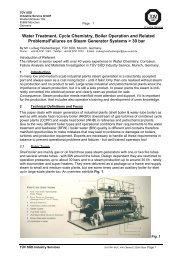Failure Analysis of Boiler Damages.pdf - Sme-gtz.org.vn
Failure Analysis of Boiler Damages.pdf - Sme-gtz.org.vn
Failure Analysis of Boiler Damages.pdf - Sme-gtz.org.vn
You also want an ePaper? Increase the reach of your titles
YUMPU automatically turns print PDFs into web optimized ePapers that Google loves.
TÜV Industrie Service GmbH<br />
TÜV SÜD Group<br />
Westendstrasse 199<br />
80686 München<br />
Germany<br />
Deposition or Scaling may also lead to<br />
Page 2<br />
• Localised concentration <strong>of</strong> impurities within or underneath <strong>of</strong> deposits at heated<br />
surfaces<br />
• ”On Load Corrosion” with acidic or alkaline attack Photo 10 – 12.<br />
Attention:<br />
– Scaling appears first at spots with high heat transfer and high steam production<br />
– Even non corrosive deposits e.g. Photo 13 - 20<br />
- iron oxides may lead to porous, thermal critical scale,<br />
- silicates as Ca-, Mg, Al-silicates to over-heating<br />
– <strong>Boiler</strong> operation according to the BFW and BW requirements for some years lead<br />
mostly<br />
to some deposits <strong>of</strong> iron oxide, which should be preventively removed<br />
Causes and Risks:<br />
∗ Insufficient on-line quality control <strong>of</strong> make-up water, condensate return or BFW<br />
∗ Measurement <strong>of</strong> “Acid Conductivity” amplifies detection <strong>of</strong> ingress <strong>of</strong> impurities like<br />
cooling<br />
water and some process media but do not indicate ingress <strong>of</strong> free caustics!<br />
∗ Lack in Inspection <strong>of</strong> not safety related components like heat exchangers and<br />
condensers<br />
∗ Preventive cleaning during operation or at shut down must be done according to the<br />
specifications<br />
Corrosion on boiler steel (carbon or low alloyed steel) can be mainly avoided, if the BFW<br />
and BW requirements were kept. Deviations may leads to<br />
• Dissolution <strong>of</strong> the important protective layer, material attack and loss in form <strong>of</strong><br />
- Uniform or General Corrosion or - more dangerous - to<br />
- Localised Corrosion (Pitting, On-load corrosion, etc.) Figs. 2 - 4<br />
• Crack formation in specific cases<br />
Attention:<br />
– Uniform or General Corrosion isn’t problem if the material loss is less than 0.1 mm/year<br />
(is easy to achieve with normal protective iron oxide layer)<br />
– Localised corrosion during operation underneath <strong>of</strong> deposits and within heated gaps as<br />
well<br />
as during stand still in form <strong>of</strong> oxygen corrosion (pitting formation)<br />
– Crack formation due to high concentration <strong>of</strong> free caustics in presence <strong>of</strong> high tensile<br />
stress (Caustic SCC) Photos 3 - 6<br />
Causes and Risks:<br />
∗ Insufficient BFW and BW composition, which do not meet the requirements <strong>of</strong> the boiler<br />
manufacturer or approved standards<br />
∗ Inadequate preservation during shut down<br />
∗ Localised concentration <strong>of</strong> acidic acting impurities e. g. cooling water or sea water<br />
ingress<br />
∗ Localised concentration <strong>of</strong> caustic acting impurities or free caustic underneath deposits<br />
within heated gaps or at heated phase boundaries<br />
TÜV SÜD Industry Services IS-ATW1-MUC, <strong>Boiler</strong> <strong>Failure</strong> 2005/11 - Page 2




